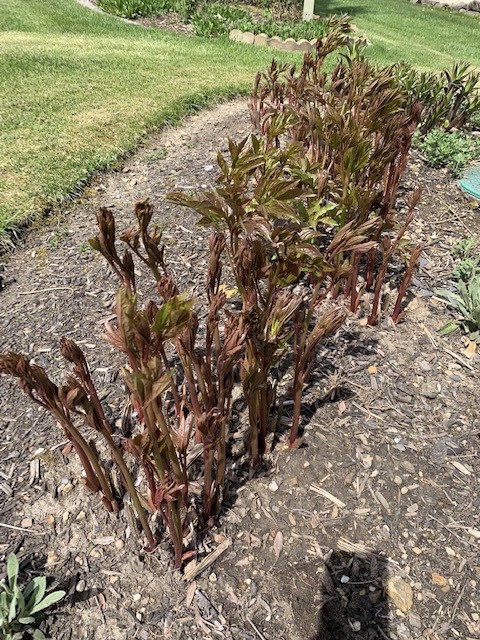Posted: May 6, 2022
Herbaceous Peonies are beautiful traditional flowers that have been loved by gardeners for many years. They make a great cut flower, and add fragrance throughout the room wherever they are placed.

Peonies are quite red because of their natural “antifreeze” when they first emerge in early spring. As they begin to leaf out, they begin to lose that red coloration. Photo Credit: Barb Mrgich
Why are there ants on my peony buds?
Herbaceous Peonies are beautiful traditional flowers that have been loved by gardeners for many years. They make a great cut flower, and add fragrance throughout the room wherever they are placed.
Peony plants are extremely long-lived perennials. One planted in the right spot, may live for well over 100 years.
They like a sunny spot in fertile, well-draining soil that has a neutral pH. They don't mind cold winters; in fact, they require the cold to bloom.
Peonies emerge early in the spring, often while the weather is still quite cold. This is the perfect time to provide grow-through supports to help prevent flopping of the big mature flower heads.
If you look closely at the new peony shoots, they look quite red, almost like rhubarb. The red color of the stems is caused by special proteins, referred to as antifreeze proteins, that prohibit the build-up of ice within the plant cells and protects the plant from freezing. Another familiar garden plant that has the same protein is Helleborus.
Gradually, those red stems develop leaves, and the peony clump begins to develop lush green foliage. By May, the large flower buds will form on the plant. After the flowers have finished, the foliage will remain attractive until fall. Keep an eye on your plants, and if you see the beginning of unhealthy leaves, cut them down to the ground immediately, and put the foliage in the trash, never the compost.
Now, back to the ants. Peony buds have "extrafloral nectaries" that secrete nectar on the outside of the bud. As you might expect, these outside-the-bud nectaries ooze a sweet liquid that attracts the ants. It is a major early season food source for them.
Some people believe the peony flower couldn't open without the ants work of clearing away the sticky liquid. Not true. This is a myth that has persisted for many years. The same plant placed up on a rooftop opens just fine without the help from the ants.
Seeing lots of ants on your peony buds should not be cause for alarm. Please, don't even think of spraying an insecticide! The ants do not harm the bud. In fact, they are part of a phenomenon which is referred to as biological mutualism, where each organism helps the other. The flowers help the ant by supplying necessary food, and the ants help the flower by killing off floral-feeding insects such as thrips that would damage and ruin the flower bud.
As soon as the bud fully opens, most of the ants will move on to search for another food source. In the meantime, if you are gathering the flowers to bring into the house, simply hold the stem just below the flower, turn it upside down, and gently tap it to knock off the ants. Another way is to gently submerge the entire flower in water, and the ants will come out quickly.
For best results, like other cut flowers, peonies should be collected early in the morning. You can also cut the stems before the buds open, place them in water, and they will open within two days. Lastly, if you really need beautiful flowers two weeks from now, cut them while they are still in bud, place them in water in the refrigerator, and get them out two days before you need them.
Barb Mrgich is a Penn State Master Gardener from Adams County. Penn State Cooperative Extension of Adams County is located at 670 Old Harrisburg Road, Suite 204, Gettysburg, phone 334-6271.

